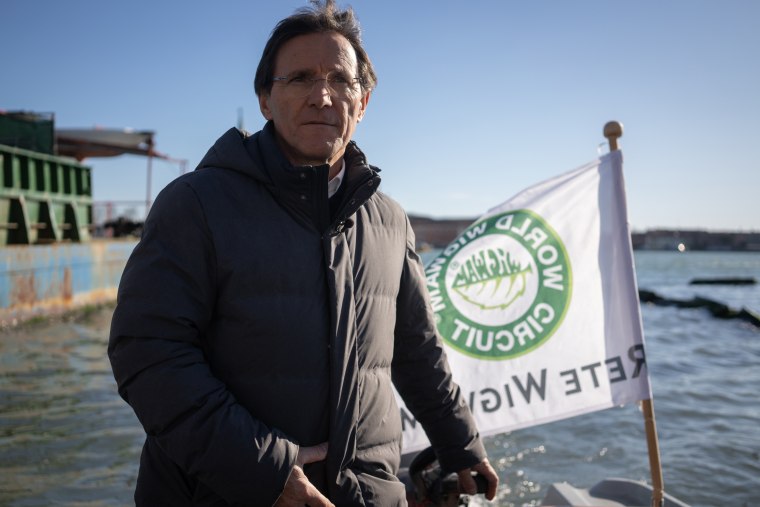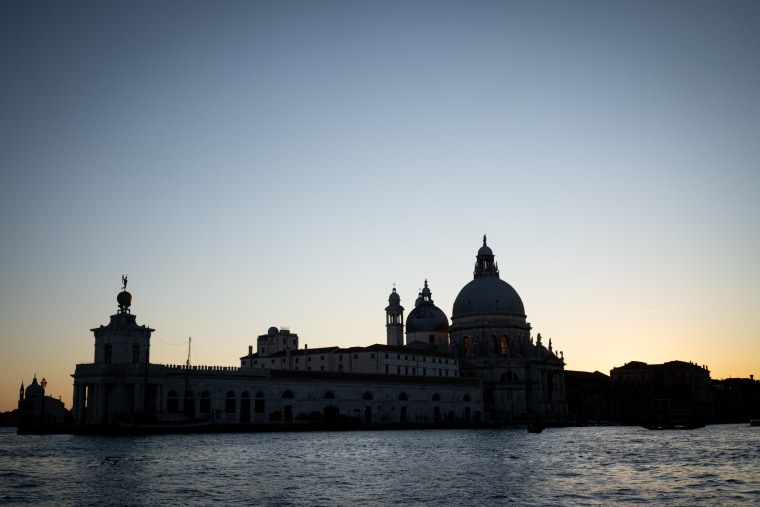VENICE, Italy — While climatologists use highly technical instruments and satellites to measure rise in global sea levels, Venetians suggest a much simpler method: just count the steps of centuries-old buildings that are now under water.
"When the palazzos on the Grand Canal were built around the 16th century, the main sea level was below the first step," Giovanni Cecconi, the president of the Venice Resilience Lab, tells NBC News.
"Nowadays, the water is about 3 feet over it. Divide that by 500 years, and you'll get an average sea rise of up to half a feet per century."

The whole city, Cecconi says, can be used as one beautiful ruler that has been measuring the changes in the average sea level across the centuries. He took NBC News for a ride on his small motorboat across the canals on a day of exceptionally low tide, when the water temporarily recedes to reveal the city's hidden treasures claimed by the sea.
"Do you see those heads of lions?" Cecconi asks, referring to a sequence of statues sculpted at the base of a palazzo. "They are all well below the green line, the main sea level drawn up by the algae. These days they are almost always underwater, but when this building was built in the 1500s, they were well visible to guests who entered it."
There is a pressing need to act. In November, a 6-foot-high tide — the second highest ever recorded — pushed by 35 mph winds submerged 80 percent of Venice. The seawater flooded shops, restaurants, residential ground floors and even the Basilica in St. Mark's Square, causing damage in excess of $1 billion.
While scientists around the world warn about the threat posed by rising seas, Venice has had the tide literally at its doorstep since its foundation — it has been adapting to it for centuries in innovative ways that can serve as an example to other coastal cities across the globe.
"What the Venetians are teaching is that when you live close to the water, you live in a continuously changing environment, in which you need the water but you also need the protection from the water," Cecconi says. "This is a continuous challenge that forces you to think and find new solutions."
Until not long ago, those solutions included raising the city at the same speed as the water by adding steps and layers to the city's banks, as well as sacrificing ground floors by walling up its doors once the water got to their level.

But the drastic acceleration in the rise of sea levels and the consequent higher and more frequent high tides mean that there is a need for new, drastic solutions.
"In the past 25 years, we noticed that the sea level has been rising four times as fast as in previous years. So we have no choice but to try to keep the excess of seawater out of the lagoon," Cecconi says.
The way to do that is as simple in theory as it is complicated in practice: a system of barriers that rest at the bottom of the three inlets that separate the Venetian Lagoon from the Adriatic Sea, which are then raised to form a floodgate only when the sea rises above critical levels.
The project's name, MOSE, is a nod to the prophet who parted the Red Sea. Its construction time frame is also of biblical proportion: The floodgate system has been under construction for the past 17 years and was initially meant to be completed by 2012. But a series of corruption scandals, rising costs and political controversies has delayed the project, which is yet to become fully operational.
In 2014, 35 people involved in the project were arrested on suspicion of corruption, bribery and kickbacks. Among them were the former mayor of Venice, Giorgio Orsoni, who was placed under house arrest for illicit party financing, and the president of the Veneto region, Giancarlo Galan, who was charged with corruption.
The MOSE project at the beginning of February still looked like a massive construction site built in the middle of the lagoon made of thick, gray concrete walls emerging from the water.
There was no sign of the watertight box-shaped gates — they were resting at the bottom of the lagoon — but it was possible to walk 60 feet below the water to seabed level and through one of the tunnels used by engineers to operate the barrier. There, Alessandro Soru, the chief engineer at MOSE, told journalists that once finished, it would be an unprecedented engineering feat.
"This is a unique floodgate system: It will be a mile long, with 78 gates ready to rise from the bottom of the sea when needed," Soru says. "There are other barriers in Rotterdam, London and New Orleans, but none of them are underwater when not in use."
In the meantime, a combination of rising sea levels and stronger storms has made tides higher and more frequent than ever, exposing Venice to the elements like never before.
Claudio Scarpa, director of the Hotels Association in Venice, says the fear factor caused by the dramatic images of the flood is a bigger threat to Venice than the immediate damage caused by the water.
"That exceptional high tide last November lasted a few hours, and yet people around the world think Venice was struck by a tsunami and it's still underwater," Scarpa said.
"In the month after the high tide, hotel bookings dropped by 50 percent. These days, they are still 20 percent below last year's average. And we are in the middle of Venice Carnival, one of the busiest times of the year."
Since November's high tide, many business owners and regular Venetians demanded answers on when the floodgate system would become operational and whether it would ever see the light of day. Others blamed MOSE, not climate change, for the worsening of tides in recent years.

On a menu at Harry's Bar, one of the oldest and most celebrated bars in Venice, a message from Arrigo Cipriani, its owner, stated: "During the past 50 years a devilish force, a Babylonian project, planned by nonsense and inexperience, has upset the lagoon. You may have noticed that for the past 40 days we have had an unusual low tide. Just an answer to the legend of the sea level rise."
"The project often grinded to a halt because of the frequent changes of governments, which is bankrolling it," Venice Mayor Luigi Brugnaro said. "The irony is that the devastating high tide last November brought the project to the world attention once again and gave it a final push."
MOSE, the mayor says, will become fully operational by 2021, but it could be activated temporarily as early as June to protect the city from exceptional tides.
Brugnaro says he doesn't only want Venice to defend itself from the effects of rising sea levels, but he wants it to become an example for other coastal cities across the world on how to face climate change.
"We want Venice to house an international water agency which studies the effects of climate change, so that we apply the lessons learned here to find solutions that work elsewhere in the world."